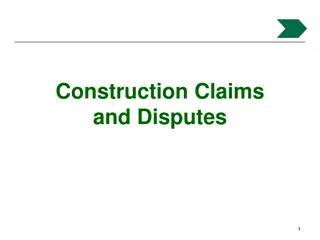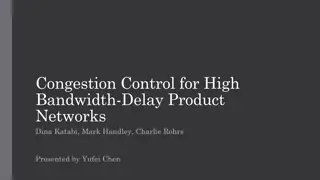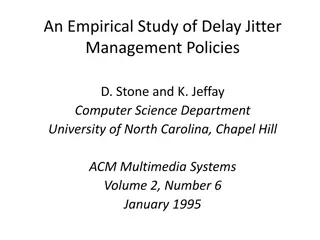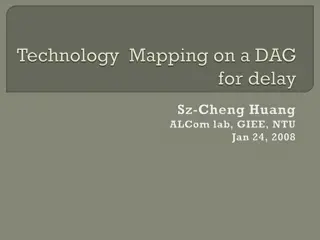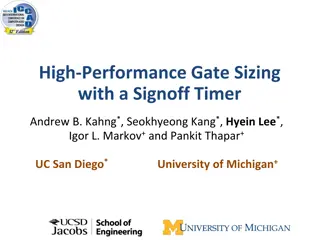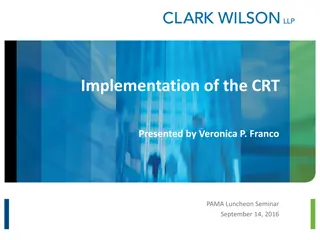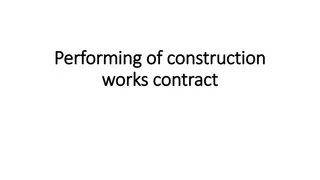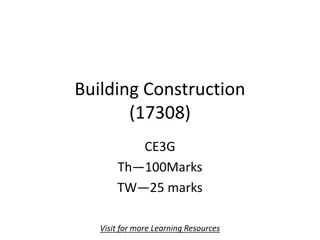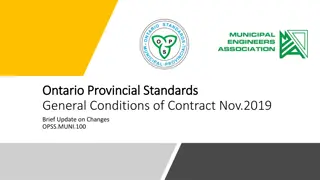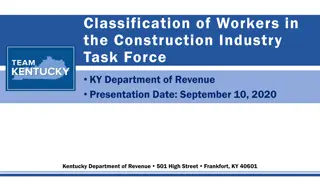Understanding Methods of Delay Analysis in Construction Disputes
Independent expert witness services play a crucial role in construction disputes by providing high-quality expert witness and tribunal services. Blackrock Expert Services, with a team of experienced professionals, offers a wide range of construction consulting services. The presentation covers the importance of careful planning, the role of work programs, and the complexities involved in delay analysis methods.
Download Presentation

Please find below an Image/Link to download the presentation.
The content on the website is provided AS IS for your information and personal use only. It may not be sold, licensed, or shared on other websites without obtaining consent from the author. Download presentation by click this link. If you encounter any issues during the download, it is possible that the publisher has removed the file from their server.
E N D
Presentation Transcript
Methods of Delay Analysis 14 November 2018
Methods of Delay Analysis Presentation by Blackrock Expert Services Mahmoud Abdelaal
Who Are We? Independent expert witness services on construction disputes: - - - performance. Blackrock Expert Services is a leading specialist professional consultancy providing high quality expert witness, tribunal and construction consulting services to the global market. Programming; Quantum; and Project Manager / Construction Manager We have the largest pool of independent expert witnesses and specialist support staff in the market: - - and Paris; - - - - architecture, mechanical engineering, electrical engineering, chemical engineering, naval architecture, industrial engineering, quantity surveying, and geology. 25 experts with over 450 years of collective experience; 110 full-time members of staff across London, Preston, Dubai, Tribunal services: - - - - - Arbitrator; Mediator; Dispute Adjudication Board (DAB); Adjudicator; and Neutral Evaluator. Analysis provided on over 300 projects; 17 different nationalities; Speaking a collective 20 languages; and Wide ranging experience including civil engineering, Construction consulting services: - - - - - - - Planning & programming; Project Management; Procurement advice; Project Controls training and development; Value engineering; Risk assessment; and Project health checks. We are currently working on some of the most complex and iconic construction projects in the world, with values up to 6bn.
Agenda Introduction- what is delay analysis? Methods of delay analysis Comparing different methods of delay analysis
Introduction Some Context Construction is complex and projects are unique. Careful planning is key Programme is a tool to plan, and monitor, not a tool to make client happy Perfect programme would show: Who should create the programme in order to achieve these criteria? Logistics; Sequence; Realistic logic links; Resources; Clear critical path; and Importantly a strategy
Introduction Work programmes can be as simple as few bar charts 2017 2018 2019 Dec Jan Feb Mar Apr May Jun Jul Aug Sep Oct Nov Dec Jan Design Procurement Construction
Introduction Or a complex schedule prepared in a specialist software
Introduction What is Delay Analysis? 2015 2016 2017 Dec Jan Feb Mar Apr May Jun Jul Aug Sep Oct Nov Dec Jan Feb Mar Apr 1- What were the critical activities (ideally at every point in time)? i.e. incidence / effect of delay Design Design Procurement Procurement Construction Construction 3 Months Delay 2- Extent of delay, how incrementally was incurred? 5 days 50 days No delay 15 days 20 days 90 days 5 days No delay 20 days 40 days Custom issues Paper work Design Changes Lack of res. No delay 3- Causes of delay
Methods of Delay Analysis SCL Delay and Disruption Protocol 2nd edition
Methods of Delay Analysis Identification of Delay Impact Key Rule: Delay event After event Time of undertaking analysis Project Period Never rely on assumptions when you know the facts PC Time of undertaking analysis Dispute Period Retrospective: Calculate the actual extent and identify cause of delay After the event Claim preparation Dispute resolution (expert analysis) Prospective: Estimate the potential impact of a delay event Ideal to undertake during currency of project to avoid dispute Contract requirement (e.g. NEC)
Methods of Delay Analysis Identification of Critical Path Prospective: critical path is identified using planned programme (i.e. baseline) Retrospective: critical path is identified using as-built programme or records Contemporaneous: critical path is identified using the contemporaneous records and knowledge of parties as at the time being analysed
Methods of Delay Analysis Type of Analysis Typically, a contractor will seek to establish the effect of a delay event once an event is identified, i.e. cause and effect. An independent expert should: First establish the effect (i.e., establish whether the works were actually delayed and identify which activities led to that delay); and then Seeks to establish the cause, i.e. effect and cause.
Methods of Delay Analysis Ideal Delay Analysis Method? If all factors allow the analyst to choose a method, then the ideal method should: Identify the actual critical path contemporaneously Identify the impact of delay retrospectively Start from the effect and then establish the cause (effect and cause)
Methods of Delay Analysis 1. Impacted As-planned Analysis 1. This analysis requires the following information: A logic-linked planned programme in its native electronic format; and Sufficient as-built information, or understanding of the facts, to determine the duration of the delay events so that they may be modelled on the baseline programme. 2. Steps: Step 1: establish the baseline programme. Step 2: model the actual duration of the selected delay event and impact the as-planned programme. Step 3: measure the change in completion date, which is said to be the critical delay caused by each delay event. 3. Reasons to perform this type of analysis: There is insufficient as-built progress information in order to understand what actually happened. The delay event is relatively straightforward and occurs at or near the commencement of the works (i.e., delay to site access). 4. Common problems with this type of analysis: This analysis requires a reasonable and fully logic-linked baseline programme. Any changes required to meet these criteria will be subjective and possibly open to criticism. This analysis provides a prospective determination of the effect of the delay event which, if performed after the actual effects become known, may be inconsistent with what actually happened. The results of this analysis are typically biased towards the party whose interest lies in maximising the impact of the delay event, as the introduction of any significant delay is likely to delay the completion date regardless if it is actually critical or not. This analysis only considers selected delay events and may ignore other more critical delay events. In this regard, this analysis favours the party selecting the events to be modelled. This type of analysis cannot be used to determine the existence of concurrent delays and/or their true effect on the critical path. In summary, this type of analysis takes no account of progress, resources, changing logic and is unlikely to be reliable in dispute resolution.
Methods of Delay Analysis 1. Impacted As-planned Analysis 2018 May Jun Jul Aug Sep Oct Planned baseline sequence typically shown by GREEN bars. B1 - Substructure B1 - Superstructure STEP 1 Establish Baseline Programme B2 - Substructure B2 - Superstructure Project Completion: 15 August The Baseline programme with the planned sequence for the construction of buildings 1 and 2. This programme is the best representation of the contractor s original planned intent. B1 - Substructure Float B1 - Superstructure STEP 2 Model the impact of the selected delay event and impact the baseline programme Delay Event B2 - Substructure B2 - Superstructure B2 - Superstructure Delay Event Remedial works to B2 substructure caused 47 days of delay. Project Completion Project Completion: 15 August Project Planned Completion Date 15-Aug Impacted Planned Completion Date 01-Oct Delays due to the Delay Event 47 STEP 3 Measure Delay 47 days of critical delay
Methods of Delay Analysis 2. Time Impact Analysis 1. This analysis requires the following information: The logic-linked planned programme in its native electronic format produced prior to the effective, or start, date of the delay event being measured. Reliable and consistent progress data, in sufficient detail and at small enough intervals to make the analysis meaningful. The anticipated programming impact of the delay event as at the effective, or start, date of delay event being modelled. 2. Steps: Step 1, note the logic-linked planned programme. Step 2, note the planned completion date within the planned programme which immediately precedes the effective, or start, date of the delay event being measured having taken account of progress. Step 3, produce a model of the anticipated impact of the delay event being measured (sometimes referred to as a fragnet ). Step 4, incorporate the delay event model into the accepted programme and measure any resulting change in the anticipated completion date. The change in the anticipated completion date is said to be the critical delay caused by the delay event. 3. Reasons to perform this type of analysis: The analysis is most reliable if performed immediately after the parties became aware of a delay event but do not yet know the eventual impact of the event. This method of analysis is prescribed within the NEC form of construction contracts. 4. Common problems with this type of analysis: This analysis relies on a prospective determination of the effect of the modelled delay event which, if performed after the actual effects become known, may be inconsistent with what actually happened. This analysis only considers selected delay events and may ignore other more critical delay events (i.e., it is a cause and effect approach). In this regard time impact analysis favours the party selecting the events to be modelled. This analysis requires a reliable fully logic-linked planned programme in its native electronic format which was produced immediately prior to the delay event, which may not be available.
Methods of Delay Analysis 2. Time Impact Analysis 2018 May Jun Jul Aug Sep Oct B1 - Substructure B1 - Superstructure STEP 1 Baseline Programme B2 - Substructure B2 - Superstructure Project Completion Start Date of the Delay Event 15 June B1 - Substructure B1 - Superstructure STEP 2 Planned Programme Immediately Before Delay Event B2 - Substructure B2 - Superstructure As-built sequence typically in BLUE. Project Completion STEP 3 Model Effect of Delay Event (Anticipated 30 days of Remedial Work) Delay Event B1 - Substructure B1 - Superstructure STEP 4 Incorporate Delay Events into Programme Update and Measure Change to Anticipated Completion Date Delay B2 - Substructure B2 - Superstructure B2 - Superstructure Project Completion Project Completion An anticipated 30-day remedial works delay event caused 15 days of critical delay to completion. STEP 2 Completion Date 31-Aug STEP 4 Completion Date 15-Sep Delays due to the Delay Event 15
Methods of Delay Analysis 3. Time Slice Windows Analysis 1. This analysis requires the following information: An electronic version of the baseline programme in its native format; A reliable and complete set of weekly or monthly programme updates in their native and electronic format; and Sufficient as-built information to explain the causes of critical delay. 2. Steps: Step 1, note the planned completion date within the baseline programme. Step 2, note the critical path and the planned completion date within the first programme update. If the planned completion date is delayed during the period between the baseline and the first update, then the source of delay is determined by means of an analysis of the available as-built information. Step 3, Step 2 is repeated between the first programme update and the second programme update, and is repeated for all subsequent updates until the final as-built programme. 3. Reasons to perform this type of analysis: This analysis is based on the programme updates which, if reliable, provide the most comprehensive set of planning information. Besides the as-planned versus as-built windows method, this is the only other analysis method which enables determination of the contemporaneous critical path, the effect of the delay events retrospectively, and is consistent with the effect and cause approach. 4. Common problems with this type of analysis: This analysis heavily relies on the programme updates, which are often found to be unreliable for a number of reasons. Contractors will often use programme updates as a commercial tool to artificially establish an entitlement to an extension of time. The level of care and bi-party review is not always provided for the updates to the same extent as to the baseline programme.
Methods of Delay Analysis 3. Time Slice Windows Analysis 2018 May Jun Jul Aug Sep Oct Critical path typically shown in RED. B1 - Substructure B1 - Superstructure STEP 1 Baseline Completion Date B2 - Substructure B2 - Superstructure Project Completion B1 - Substructure Delay B1 - Superstructure B2 - Superstructure STEP 2 Update 1 Planned Completion Update 1 Planned Completion Date 6 September (22 days of delay) B2 - Superstructure Project Completion An analysis of the project s facts on 1 July: Lack of access to Building 1 caused 22 days to the start of the Building 1 works. Building 1 was critically driving project completion at the start and end of the window. The anticipated project completion date was delayed by 22 days The lack of access to Building 1 caused 22 days of critical delay to completion.
Methods of Delay Analysis 3. Time Slice Windows Analysis 2018 May Jun Jul Aug Sep Oct B1 - Substructure Delayre B1 - Superstructure Update 1 Planned Completion Date 6 September STEP 2 Update 1 Planned Completion B2 - Substructure B2 - Superstructure Project Completion B1 - Substructure Delay B1 - Superstructure Update 2 Planned Completion Date 1 October (25 days later than update 1) B2 - Substructure B2 - Substructure STEP 2a Update 2 Planned Programme B2 - Superstructure Project Completion An analysis of the project s facts on 1 August: It took 47 days to perform remedial works on Building 2 foundations. Building 1 was critically driving project completion at the start of the window. Building 2 was critically driving project completion at the end of the window. The anticipated project completion date was delayed by 25 days in the window. Accordingly, the 47-day remedial works delay event pushed Building 2 onto the critical path and caused 25 days of critical delay
Methods of Delay Analysis 3. Time Slice Windows Analysis 2018 May Jun Jul Aug Sep Oct Delay B1 - Substructure B1 - Superstructure STEP 2a Update 2 Planned Programme Update 2 Planned Completion Date 1 October B2 - Substructure B2 - Substructure B2 - Superstructure Project Completion Delay B1 - Substructure B1 - Superstructure STEP 2b Update 3 Planned Programme B2 - Substructure B2 - Substructure B2 - Substructure B2 - Superstructure Project Completion Update 3 Planned Completion Date 1 October (no delay) An analysis of the project s facts on 1 September: There was no change in the planned completion date between updates 2 and 3. Accordingly, there was no critical delay in the window. DELAY AND QUANTUM
Methods of Delay Analysis 3. Time Slice Windows Analysis 2018 May Jun Jul Aug Sep Oct B1 - Substructure Delay B1 - Superstructure B1 - Superstructure Delay STEP 2b Update 3 Planned Programme B2 - Substructure B2 - Substructure B2 - Superstructure B2 - Substructure Update 3 Planned Completion Date 1 October (no delay) Project Completion B1 - Substructure Delay STEP 2c Update 4 Planned Programme (As-Built) B1 - Superstructure B1 - Superstructure Delay B2 - Substructure B2 - Substructure B2 - Superstructure Project Completion Update 4 Completion Date 1 October (no delay) EXTENT OF DELAY WINDOW DELAY EVENT 1 Lack of access to Building 1 22 2 Remedial works on Building 2 foundations 25 TOTAL DELAY 47 An analysis of the project s facts on 1 October: There was no change in the planned completion date between updates 3 and 4. Accordingly, there was no critical delay in the window. DELAY AND QUANTUM
Methods of Delay Analysis 4. As-planned versus As-built Windows Analysis 1. This analysis requires the following information: Baseline programme; As-built programme; Sufficient as-built information, or understanding of the facts, to determine the actual critical path; and Sufficient as-built information to explain the causes of critical delay. 2. Steps: Step 1, establish the baseline programme. Step 2, establish the as-built programme and the actual critical path through an analysis of the project s facts and practical experience. Step 3, divide the actual critical path into windows of time which represent a single critical activity or a discrete set of critical activities. Step 4, measure the extent of delay incurred at the start and end of each window by reference to the baseline programme. Step 5, calculate the extent of delay incurred in each window and examine the project records in order to determine the causes of delay. 3. Reasons to perform this type of analysis: The programme updates are too few or unreasonable, thereby preventing their use for a time slice windows method of delay analysis. Besides the time slice windows method, this is the only method of analysis which determines the critical path contemporaneously, the effect of the delay events retrospectively and is consistent with the effect and cause approach. 4. Common problems with this type of analysis: Unreasonable assumptions in the baseline programme can lead to unreasonable results. The analysis supporting the determination of the critical path is not sufficiently robust. Project records may be inadequate to accurately determine the causes of delay. DELAY AND QUANTUM
Methods of Delay Analysis 4. As-planned versus As-built Windows Analysis 2018 May Jun Jul Aug Sep Oct B1 - Substructure STEP 1 Establish Baseline B1 - Superstructure B2 - Substructure B2 - Superstructure Project Completion B1 - Substructure B1 - Superstructure STEP 2 Establish As-built Programme and Critical Path Float B2 - Superstructure Project Completion An analysis of the project s facts and practical experience leads to the following critical path conclusions: 1 June 7 July, the critical path starts in building 1 s substructure because it was delayed while building 2 was not. 7 July, the critical path switched to building 2 s substructure due to its continuing substructure delays and starting building 1 s superstructure ahead of the planned sequence. 7 July 1 October, the critical path is maintained in building 2 s substructure and superstructure sequence as it drives project completion DELAY AND QUANTUM
Methods of Delay Analysis 4. As-planned versus As-built Windows Analysis 2018 May Jun Jul Aug Sep Oct B1 - Substructure B1 - Superstructure STEP 3 Establish Windows B2 - Substructure Float B2 - Superstructure Project Completion Window 2 Window 4 Window 3 Window 1 Divide the actual critical path into windows of time which represent a single critical activity/event or a discreet set of critical activities/events. WINDOW START END CRITICAL WORKS 1 01-Jun 23-Jun Delay to start of building 1 substructure 2 23-Jun 07-Jul Building 1 substructure works 3 07-Jul 30-Jul Continuing delay to completion of building 2 substructure 4 30-Jul 01-Oct Building 2 superstructure DELAY AND QUANTUM
Methods of Delay Analysis 4. As-planned versus As-built Windows Analysis 2018 May Jun Jul Aug Sep Oct A B1 - Substructure B B1 - Superstructure STEP 4 Measure Delay C B2 - Substructure D B2 - Superstructure Project Completion E B A B1 - Substructure B1 - Superstructure Float B2 - Substructure C B2 - Superstructure D Project Completion E Window 2 Window 1 Window 3 Window 4 ACTUAL DATE WINDOW MILESTONE DATES PLAN DATE DELAY A B Start Works Start B1 Substructure Finish B2 Substructure Planned Works Start B2 Superstructure Project Completion 01-Jun 01-Jun 15-Jun 15-Jun 15-Aug 01-Jun 23-Jun 07-Jul 01-Aug 01-Oct 0 22 22 47 47 C D E DELAY AND QUANTUM
Methods of Delay Analysis 4. As-planned versus As-built Windows Analysis 2018 May Jun Jul Aug Sep Oct B1 - Substructure STEP 5 Calculate and Determine the Causes of Critical Delays B1 - Superstructure B2 - Substructure B2 - Superstructure Delay Event 1 Lack of access to building 1 caused 22 days of critical delay. Project Completion B1 - Substructure B1 - Superstructure B2 - Substructure Float B2 - Superstructure Delay Event 2 Lack of access to building 2 caused 25 days of critical delay. Project Completion DELAY AT START 0 22 22 47 DELAY AT END 22 22 47 47 DELAY IN WINDOW 22 0 25 0 47 WINDOW CAUSES OF DELAY 1 2 3 4 Lack of access to building 1 - Remedial works to building 2 - TOTAL DELAY DELAY AND QUANTUM
Methods of Delay Analysis 5. Longest Path Analysis 1. This analysis requires the following information: Baseline programme; As-built programme; Sufficient as-built information, or understanding of the facts, to determine the as-built critical path; and Sufficient information to explain the causes of critical delay. 2. Steps: Step 1, establish the as-built critical path by tracing the driving sequence of events backwards from completion. The next steps are the same as outlined in the as-planned versus as-built windows analysis. 3. Reasons to perform this type of analysis: The programme updates are too few or unreasonable, thereby preventing their use in a time slice windows method of delay analysis. 4. Common problems with this type of analysis: This analysis relies on a retrospective determination of the critical path which does not allow for switches in the critical path. Large complex construction projects often experience several critical path changes during the progress of the works. This analysis does not allow for switches in the as-built critical path. Explaining a switch in the actual critical path as part of an as-planned versus as-built windows analysis can be difficult. This type of analysis cannot be used to determine the existence of concurrent delays and/or their true effect on the critical path. DELAY AND QUANTUM
5. Longest Path Analysis 2018 May Jun Jul Aug Sep Oct Delay B1 - Substructure STEP 1 Establish As-built Critical Path B1 - Superstructure Delay B1 - Superstructure Float B2 - Substructure B2 - Substructure Follow the longest sequence backwards to establish the as-built critical path. B2 - Superstructure Project Completion The Longest Path Analysis leads to the following critical path conclusions: 1 June 31 July, the critical path starts in building 2 s substructure. 1 August 1 October, the critical path continues in building 2 s superstructure until the completion of the project. B1 - Substructure B1 - Superstructure STEP 2 Establish Baseline B2 - Substructure B2 - Superstructure Project Completion The Baseline programme with the planned sequence for the construction of buildings 1 and 2. This programme is the best representation of the contractor s original planned intent. DELAY AND QUANTUM
Methods of Delay Analysis 5. Longest Path Analysis 2018 May Jun Jul Aug Sep Oct Delay B1 - Substructure B1 - Superstructure Delay B1 - Superstructure STEP 3 Establish Windows Float B2 - Substructure B2 - Substructure B2 - Superstructure Project Completion Window 3 Window 2 Window 1 WINDOW 1 2 3 START 01-Jun 15-Jun 01-Aug END 15-Jun 01-Aug 01-Oct CRITICAL ACTIVITIES Substructure of Building 2 Delays in the Substructure of Building 2 Superstructure of Building 2 DELAY AND QUANTUM
Methods of Delay Analysis 5. Longest Path Analysis 2018 May Jun Jul Aug Sep Oct A B1 - Substructure B1 - Superstructure B B2 - Substructure B2 - Superstructure C D Project Completion Delay B1 - Substructure STEP 4 Measure Delay B1 - Superstructure Delay B1 - Superstructure B A C Float B2 - Substructure B2 - Substructure B2 - Superstructure D Project Completion Window 2 Window 3 Window 1 ACTUAL DATE 01-Jun 15-Jun 01-Aug 01-Oct WINDOW MILESTONE DATES PLAN DATE DELAY A Start Works Finish B2 Substructure Finish B2 Substructure Remedial works Project Completion 01-Jun 15-Jun 15-Jun 15-Aug 0 0 B C D 47 47
Methods of Delay Analysis 5. Longest Path Analysis 2018 May Jun Jul Aug Sep Oct B1 - Substructure B1 - Superstructure B2 - Substructure B2 - Superstructure Project Completion Delay B1 - Substructure STEP 5 Measure and Determine the Causes of Critical Delays B1 - Superstructure Delay B1 - Superstructure Float B2 - Substructure B2 - Substructure B2 - Superstructure Delay Event Remedial works to B2 substructure caused all of the 47 days of critical delay to completion. Window 2 Window 1 Window 3 Project Completion DELAY AT START 0 0 47 DELAY AT END 0 47 47 DELAY IN WINDOW 0 47 0 47 WINDOW CAUSES OF DELAY 1 2 3 - Remedial works to building 2 substructure - TOTAL DELAY
Methods of Delay Analysis 6. Collapsed As-built Analysis 1. This analysis requires the following information: An as-built programme including as-built logic; and Sufficient as-built information to explain how the delay event(s) being modelled affected the as-built programme. 2. Steps: Step 1, establish a comprehensive logic-linked as-built programme by reference to project records. Step 2, identify the delay event in question on the as-built programme. Step 3, remove the selected delay event from the as-built programme and calculate the change or collapse in the project s completion date, if any. The extent of the change in the completion date represents the critical delay caused by the modelled delay event. 3. Reasons to perform this type of analysis: There is no baseline programme, thereby preventing the use of several of the other types of methods of delay analysis. The logic behind this analysis is straightforward. A collapsed as-built analysis sets out what might have happened had the delay event not occurred. 4. Common problems with this type of analysis: The results of this analysis are predicated on a hypothetical model. Removing an event which actually happened from the as-built programme presents a situation which never actually happened. The results of this analysis are typically biased towards the party whose interest lies in minimising the impact of the delay event, as the changed completion date will typically collapse back to the next most delayed sequence. Establishing a comprehensive logic-linked as-built programme is typically a forensic and subjective exercise which is likely to face heavy scrutiny/criticism by the other party. This method allows the analyst to assess as many or as few events as desired (i.e., it is a cause and effect approach). Modelling a limited number of selected events can provide a biased result. This type of analysis cannot be used to determine the existence of concurrent delays and/or their time effect on the critical path.
Methods of Delay Analysis 6. Collapsed As-built Analysis 2018 May Jun Jul Aug Sep Oct B1 - Substructure B1 - Superstructure STEP 1 Establish As-built programme and logic B2 - Substructure Float B2 - Superstructure Project Completion B1 - Substructure B1 - Superstructure STEP 2 Identify a selected delay event Float B2 - Substructure B2 - Substructure B2 - Superstructure Delay Event Remedial works to building 2 substructure Project Completion 21-day improvement to Project Completion (10 September from 1 October), so the delay event is said to have caused 21 days of critical delay. B1 - Substructure B1 - Superstructure STEP 3 Remove selected delay events and measure effect of delay B2 - Substructure B2 - Substructure B2 - Substructure B2 - Superstructure Project Completion Project Completion Remove delay event and collapse back programme
Methods of Delay Analysis Summary As-Planned v As-Built Windows Impact As- Planned Collapsed As- Built METHOD OF DELAY ANALYSIS Time Impact Time Slice Longest Path Lack of access to Building 1 0 - 22 22 0 - Remedial works to Building 2 foundations 47 15 25 25 47 21 Total 47 - 47 47 47 - Not all delay event impacts have been calculated for each method. Therefore, the Remedial works to Building 2 foundations in the red box is the most appropriate for comparative purposes.
Methods of Delay Analysis Any Questions?



